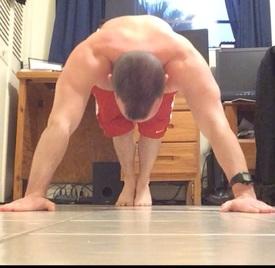Where's the line between strength training and cardio?

gr34t
Posts: 15 Member
Where does cardio/aerobic training end and strength training begin?
Sure, the swift stroll or occasional jog around the lake is something most people would call cardio while deadlifts are clearly more of a strength exercise.
But how does serious sprint interval training fit in there (which, physiologically speaking, is as far from jogging as table tennis is from squash)? Or HIIT with advanced own-body-weight (and/or added weight) exercises (if I look at some of the genuine physical results of Insanity, one might say that this is not simply aerobics)? I believe that on this board, strength training and lifting is often used interchangeably while sometimes dismissing anything not involving a free weights area - which leads to half-truths for a lot of exercise novices reading these forums.
I'm not trying to stir up an ideological debate. Rather, I'm interested in the very practical experience and opinions of seasoned sportsmen and -women here.
For someone like me who can neither run 5km without walking in-between nor doing a single full pull-up, I'd consider almost all exercises which exhaust you very quickly strength training. Even doing squats without added weight (random fact: Schwarzenegger mentioned in his autobiography that he was doing up to 1000 squats a day in his usual pre-competition routine).
Sure, the swift stroll or occasional jog around the lake is something most people would call cardio while deadlifts are clearly more of a strength exercise.
But how does serious sprint interval training fit in there (which, physiologically speaking, is as far from jogging as table tennis is from squash)? Or HIIT with advanced own-body-weight (and/or added weight) exercises (if I look at some of the genuine physical results of Insanity, one might say that this is not simply aerobics)? I believe that on this board, strength training and lifting is often used interchangeably while sometimes dismissing anything not involving a free weights area - which leads to half-truths for a lot of exercise novices reading these forums.
I'm not trying to stir up an ideological debate. Rather, I'm interested in the very practical experience and opinions of seasoned sportsmen and -women here.
For someone like me who can neither run 5km without walking in-between nor doing a single full pull-up, I'd consider almost all exercises which exhaust you very quickly strength training. Even doing squats without added weight (random fact: Schwarzenegger mentioned in his autobiography that he was doing up to 1000 squats a day in his usual pre-competition routine).
0
Replies
-
Honestly, this depends on what your goals are. For me, I want to one day run an ultra...so strength is centered around making my running more effective, core support, etc... I run 5 days a week and lift for 2. But those are -MY- goals....someone may be more strength centered and so chose to do strength exercises more than cardio.0
-
1-8 reps vs 10-15 reps. :bigsmile:
In your example, Insanity really is cardio. The only reason why muscles look bigger in the results pics is because (1) the person really had very little muscular size and even just a little exercise triggered growth but there will be a limit, (2) the individual had muscle that was covered in fat, removing the fat makes the muscle appear bigger.0 -
hmm.0
-
The general concensus is that 12+ reps gets into the conditioning/cardio area.
Sprint training is still cardio, though it is more anabolic if done all out. I'm sure it contributes some to your strength, especially if you also use resistance.
Cardio classes with weight don't make you much stronger because of how low the weight is, unless you're relatively untrained.0 -
cool thread, bump0
-
There is no clear line between strength training and cardio. "Cardio" refers to exercises that been shown to increase cardio-vascular health (or, to be more precise, they decrease incidence of heart and/or vascular disease). Almost all exercise is "cardio" because almost all exercise is good for the cardio-vascular system when done properly (over-training in an form may be harmful).
But some use cardio to only mean non-strength training, which still leaves a very blurry line. Calisthenics, plyometrics, HIIT, and other exercise are often called "cardio", but all can increase strength, endurance and muscle. And all often are more anaerobic than aerobic.
Likewise, weights are rarely referred to as cardio, yet studies have shown that lifting weights can improve heart health.
And then there are things like yoga or Tai Chi, which are not aerobic and often don't build strength or muscle, yet can still improve heart health through the reduction of stress.0 -
Strength training in and of itself is a tricky term, sort of a gray area, and I suspect there's going to be a lot of different answers on this one. To me what you describe is more like circuit training which is mostly cardio but you can technically build strength (be able to lift more, improve muscle endurance) although you won't likely build actual muscle mass. As the other poster pointed out, results are more about fat loss which allows the muscle to show more.
Also, if we're strictly talking hypertrophy (muscle gains) that's not just about the # of reps you do but nutrition, timing, rest, etc0 -
IMHO, when done right, all strength training has cardiovascular benefits. However, almost no cardio is also strength training.
For example, I lift weights and HATE cardio (seriously. I call it the hamstermill. haaaaaaaaaate cardio). I do almost none of it, although I know I should. However, I recently took my 8 month old dogs for a hike, and they decided to RUN. I am NOT a runner...when I played softball I learned how to hit further so I didn't have to run as hard (strength vs cardio, LOL). But I actually RAN almost a mile with those damn puppies. I would NOT have been able to do that a year ago. Therefore, my strength training has also improved my cardio.
ETA cardio can often visually appear to have similar results as strength training, when in reality, the person has lost fat & made the existing muscles more visible. Just my $0.02.0 -
Are you asking about the difference between "circuit training" cardio with weights-type stuff vs. actually training for strength or mass building?0
-
The difference between "strength" and "cardio" is more defined by the physiological effects of the training activity, not by the activity itself.
For example, lifting a kettlebell overhead with a height that maxes you out in 8 repetitions is a "strength" exercise. Doing kettlebell swings for 15 minutes is cardio.
Think of it as a continuum. Every activity has what I call an "aerobic" component and a "resistive" component. At one end is something like 1-3 RM squats. The resistive component is quite high, the aerobic component is negligible. At the other is lower-intensity, steady state endurance cardio. The effect is mostly aerobic with little resistive component.
Everything else is going to be a combination. And the effect may be different for each individual depending on conditioning, experience, etc.
It gets a little confusion sometimes because of the principle of training adaptation. Any time you try a new activity, the body will adapt to the specific demands of that activity. Once it can meet those demands, then no further adaptation will occur, but that initial change can lead inexperienced people to think something else is happening. For example, an unfit person who starts exercising on a cross trainer, or other cardio piece will experience an initial increase in "strength" as the body adapts to the specific demands of moving the pedals and pushing the arms back and form. That may actually translate into the person feeling "stronger" as they walk up a fight of stairs. The person might then conclude that the cross trainer provides simultaneous training for both muscle strength and cardio--but it doesn 't. Once the muscles get use to operating the machine, further "strength" gains will cease.
The waters become muddied further when doing HIIT or "metabolic" style workouts, using strength-type movements. Since these will usually involve a higher level of resistance in the movements, there will be greater strength increases, along with the aerobic fitness increase. However, the effect is not the same as a more traditional weight lifting routine. It is up to the individual to decide if those strength increases are sufficient to meet his or her goals.
Another confounding factor is heart rate. The average person has been conditioned to believe that "increased HR = aerobic training" in all cases. This leads people to believe that if they move quickly through their weight exercises and keep their heart rates elevated, they will experience simultaneous strength and cardio training. That is not true, however. Heart rate during exercise can increase for different reasons. During cardio training, increased heart rate is accompanied by increase cardiac output and increase oxygen uptake. During strength training, heart rate increases by a completely different mechanism with little increase in either cardiac output or oxygen uptake. So while a heart rate monitor might show the same elevated heart rate during the two activities, the effect on the body is completely different.
In summary: the greater the strength training effect, the less the cardio training effect and vice versa. If you want to do concurrent workouts like circuit training, there will be a compromise--you won't get the same effect as from a dedicated cardio or strength program. However, those results may be sufficient to reach your goals. You just have to make sure you understand what training effect the activity has and design workouts that meet your needs.0 -
Thanks. That was a really helpful explanation!0
-
So most would agree that doing push ups when you're able to not do more than 8 in a row is a strength exercise, but as you're getting stronger and are able to do 20+, it's more of a cardio one?
-
Thanks Azdak for your response!0
This discussion has been closed.
Categories
- All Categories
- 1.4M Health, Wellness and Goals
- 398.1K Introduce Yourself
- 44.7K Getting Started
- 261K Health and Weight Loss
- 176.4K Food and Nutrition
- 47.7K Recipes
- 233K Fitness and Exercise
- 462 Sleep, Mindfulness and Overall Wellness
- 6.5K Goal: Maintaining Weight
- 8.7K Goal: Gaining Weight and Body Building
- 153.5K Motivation and Support
- 8.4K Challenges
- 1.4K Debate Club
- 96.5K Chit-Chat
- 2.6K Fun and Games
- 4.8K MyFitnessPal Information
- 12 News and Announcements
- 21 MyFitnessPal Academy
- 1.5K Feature Suggestions and Ideas
- 3.2K MyFitnessPal Tech Support Questions










